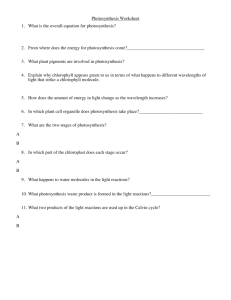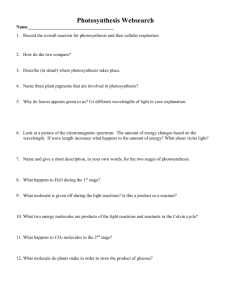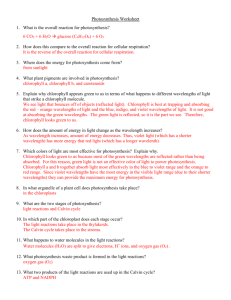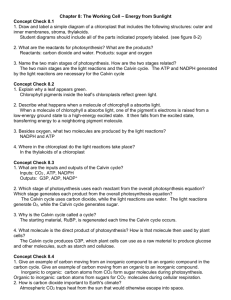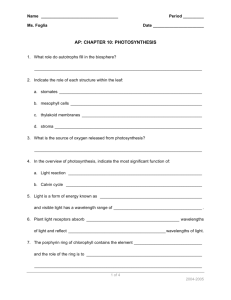Photosynthesis Questions and Answers
advertisement
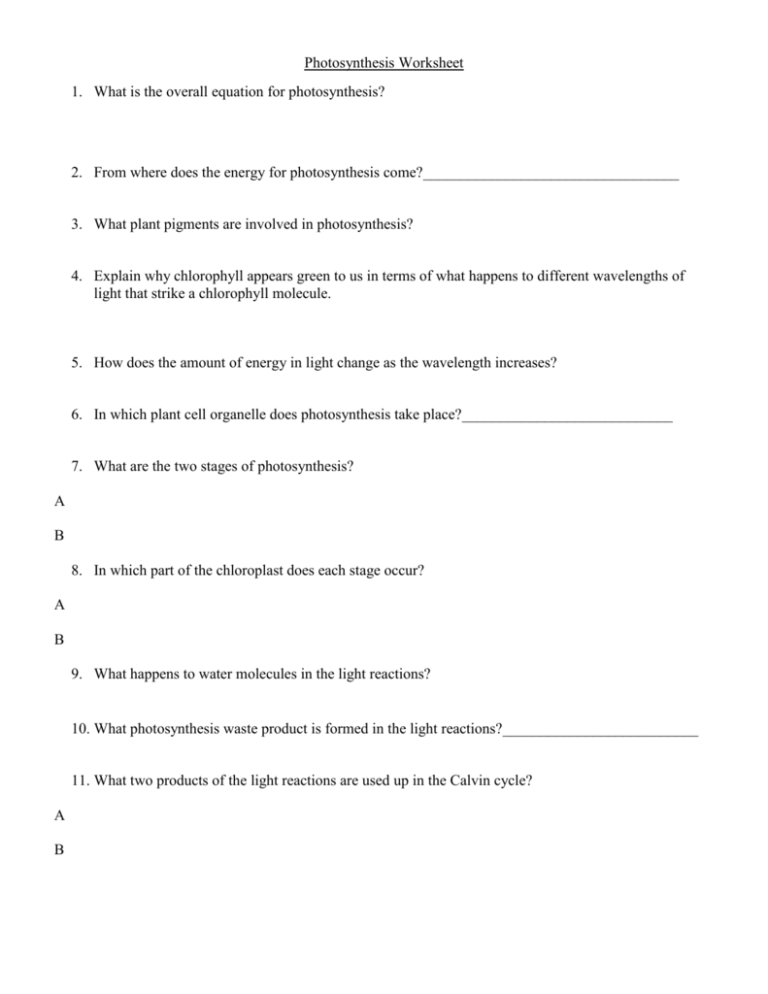
Photosynthesis Worksheet 1. What is the overall equation for photosynthesis? 6 CO2 + 6 H2O glucose (C6H12O6) + 6 O2 It is the reverse of the overall reaction for cellular respiration. 2. From where does the energy for photosynthesis come?__________________________________ from sunlight 3. What plant pigments are involved in photosynthesis? chlorophyll a, chlorophyll b, and carotenoids 4. Explain why chlorophyll appears green to us in terms of what happens to different wavelengths of light that strike a chlorophyll molecule. We see light that bounces off of objects (reflected light). Chlorophyll is best at trapping and absorbing the red – orange wavelengths of light and the blue, indigo, and violet wavelengths of light. It is not good 5. How does the amount of energy in light change as the wavelength increases? As wavelength increases, amount of energy decreases. Thus, violet light (which has a shorter wav 6. In which plant cell organelle does photosynthesis take place?____________________________ in the chloroplasts 7. What are the two stages of photosynthesis? light reactions and Calvin cycle A B 8. In which part of the chloroplast does each stage occur? Ahe light reactions take place in the thylakoids. The Calvin cycle takes place in the stroma. B 9. What happens to water molecules in the light reactions? Water molecules (H2O) are split to give electrons, H+ ions, and oxygen gas (O2) . 10. What photosynthesis waste product is formed in the light reactions?__________________________ oxygen gas (O2) 11. What two products of the light reactions are used up in the Calvin cycle? AATP and NADPH B 12. What happens to carbon dioxide molecules in the Calvin cycle reactions? In the Calvin cycle, carbon dioxide molecules (CO2) are combined with each other and with the electrons and H’s from NADPH to form glucose (C6H12O6). 13. How can cells store the sugar that is produced in photosynthesis? It is stored as starch. 14. Label the diagram below to summarize the two stages of photosynthesis. Use the word bank below the diagram to fill in the blanks. 2. H2O 3. CO2 1. light 4. stroma _____ 4. 7. NADP+ 8.ADP+P_ 5. granum 11. Calvin Cycle 6. light reaction 9.ATP 12. 12._______ thylakoid 13. O2 10.NADPH __ 14. sugar Word list: thylakoids granum stroma light reactions Calvin cycle light H2 O sugar CO2 NADPH ATP NADP+ O2 ADP + P Photosynthesis Worksheet 1. What is the overall reaction for photosynthesis? 6 CO2 + 6 H2O glucose (C6H12O6) + 6 O2 2. How does this compare to the overall reaction for cellular respiration? It is the reverse of the overall reaction for cellular respiration. 3. Where does the energy for photosynthesis come from? from sunlight 4. What plant pigments are involved in photosynthesis? chlorophyll a, chlorophyll b, and carotenoids 5. Explain why chlorophyll appears green to us in terms of what happens to different wavelengths of light that strike a chlorophyll molecule. We see light that bounces off of objects (reflected light). Chlorophyll is best at trapping and absorbing the red – orange wavelengths of light and the blue, indigo, and violet wavelengths of light. It is not good at absorbing the green wavelengths. The green light is reflected, so it is the part we see. Therefore, chlorophyll looks green to us. 6. How does the amount of energy in light change as the wavelength increases? As wavelength increases, amount of energy decreases. Thus, violet light (which has a shorter wavelength) has more energy that red light (which has a longer wavelenth). 7. Which colors of light are most effective for photosynthesis? Explain why. Chlorophyll looks green to us because most of the green wavelengths are reflected rather than being absorbed. For this reason, green light is not an effective color of light to power photosynthesis. Chlorophyll a and b together absorb light most effectively in the blue to violet range and the orange to red range. Since violet wavelengths have the most energy in the visible light range (due to their shorter wavelengths) they can provide the maximum energy for photosynthesis. 8. In what organelle of a plant cell does photosynthesis take place? in the chloroplasts 9. What are the two stages of photosynthesis? light reactions and Calvin cycle 10. In which part of the chloroplast does each stage occur? The light reactions take place in the thylakoids. The Calvin cycle takes place in the stroma. 11. What happens to water molecules in the light reactions? Water molecules (H2O) are split to give electrons, H+ ions, and oxygen gas (O2) . 12. What photosynthesis waste product is formed in the light reactions? oxygen gas (O2) 13. What two products of the light reactions are used up in the Calvin cycle? ATP and NADPH 14. What happens to carbon dioxide molecules in the Calvin cycle reactions? In the Calvin cycle, carbon dioxide molecules (CO2) are combined with each other and with the electrons and H’s from NADPH to form glucose (C6H12O6). 15. How can cells store the sugar that is produced in photosynthesis? It is stored as starch. 16. Label the diagram below to summarize the two stages of photosynthesis. Use the word bank below the diagram to fill in the blanks. 2. H2O 3. CO2 1. light 4. stroma _____ 4. 7. NADP+ 8.ADP+P_ 5. granum 11. Calvin Cycle 6. light reaction 9.ATP 12. 12._______ thylakoid 13. O2 10.NADPH __ 14. sugar Word list: thylakoids granum stroma light reactions Calvin cycle light H2 O sugar CO2 NADPH ATP NADP+ O2 ADP + P
